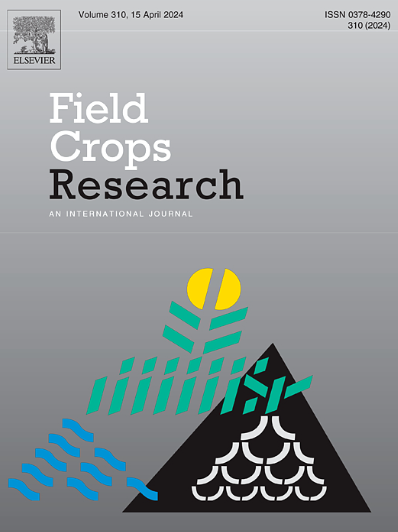Nitrogen reduction and split application increased grain yield and agronomic nitrogen use efficiency of oilseed flax (Linum usitatissimum. L) by increasing nitrogen status
IF 5.6
1区 农林科学
Q1 AGRONOMY
引用次数: 0
Abstract
Context
Accurate monitoring of crop nitrogen status is the premise of precise nitrogen application. However, there is a lack of general diagnostic approach for the nitrogen status of oilseed flax, and the mechanism of nitrogen fertilizer managements influencing oilseed flax grain yield and agronomic nitrogen use efficiency (aNUE) is still unclear.
Objectives or methods
Six nitrogen application rates (0 (N0), 60 (N60), 90 (N90), 120 (N120), 150 (N150), and 180 (N180) kg hm−2) and three split application methods (T1, 100 % of nitrogen at pre-sowing; T2, 2/3 of nitrogen at pre-sowing + 1/3 at budding stage; T3, 1/3 of nitrogen at pre-sowing + 1/3 at branching stage + 1/3 at budding stage) were designed. A critical nitrogen concentration model for oilseed flax was constructed. Then, the effects of different nitrogen fertilizer managements on dry matter and nitrogen accumulation, distribution, translocation, grain yield, and aNUE, as well as relationships between these indices and plant accumulated N deficit (Nand)/nitrogen nutrition index (NNI) of oilseed flax were analyzed.
Results
The dry matter-based critical nitrogen concentration model for oilseed flax was Y= 2.4507X-0.33473, with an R2 of 0.91294. Compared with the traditional nitrogen application rate (N180), nitrogen reduction by 33 % (N120) reduced the full-season NNI, nitrogen accumulation, and TransN (pre-anthesis nitrogen translocation from vegetative organs to reproductive organs) by 8.91 %-19.77 %, 10.80 %, and 10.53 %, respectively (p < 0.05), and increased Nand, dry matter accumulation, proportions of dry matter allocated to leaves (PDL) and reproductive organs (PDR) at maturity stage, TransD (pre-anthesis dry matter translocation from vegetative organs to reproductive organs), TransD rate, grain yield, and aNUE by 73.42 %-118.31 %, 4.24 %, 4.81 %, 3.02 %, 9.73 %, 15.89 %, 7.43 %, and 121.92 %, respectively (p < 0.05). Compared with T1, T2 increased the dry matter accumulation, PDL, PDR, TransD, nitrogen accumulation, proportion of nitrogen allocated to reproductive organs at maturity stage, grain yield, and aNUE by 4.99 %, 45.42 %, 4.00 %, 21.80 %, 11.24 %, 8.87 %, 4.09 %, and 50.95 %, respectively (p < 0.05).
Conclusions or implications
Among the nitrogen fertilizer managements, the optimal mode N120T2 could improve oilseed flax nitrogen status, coordinate the source-sink relationship in plants to efficiently use photosynthetic assimilates, and promote the translocation of photosynthetic assimilates to sink organs in the late growth stage, thereby increasing the grain yield and aNUE. This study will provide a technical means for precise nitrogen fertilization and yield increase in oilseed flax in the semi-arid region in China.
氮素减量和分施提高了油籽亚麻籽粒产量和氮素农艺利用率。L)通过提高氮态
准确监测作物氮素状况是精确施氮的前提。然而,目前缺乏油籽亚麻氮素状况的通用诊断方法,氮肥管理对油籽亚麻籽粒产量和农艺氮素利用效率(aNUE)的影响机制尚不清楚。目的或方法6种氮肥施用量(0 (N0)、60 (N60)、90 (N90)、120 (N120)、150 (N150)和180 (N180) kg hm−2)和3种分施方法(T1、100 %播前施氮;T2,播前施2/3 +出芽期施1/3;T3,播前施氮量为1/3 +分枝期施氮量为1/3 +出芽期施氮量为1/3)。建立了油籽亚麻临界氮浓度模型。在此基础上,分析了不同氮肥管理对油籽亚麻干物质和氮积累、分配、转运、籽粒产量和aNUE的影响,以及这些指标与植株累积氮亏缺(Nand)/氮营养指数(NNI)的关系。结果基于干物质的油籽亚麻临界氮浓度模型为Y= 2.4507X-0.33473, R2为0.91294。与传统施氮量(N180)相比,氮素减量33% % (N120)使成熟期全季NNI、氮素积累量和TransN(花前营养器官向生殖器官的氮转运量)分别降低8.91 % ~ 19.77 %、10.80 %和10.53 % (p <; 0.05),增加了Nand、干物质积累量、分配给叶片(PDL)和生殖器官(PDR)的干物质比例。TransD (pre-anthesis从营养器官干物质易位生殖器官),TransD率、粮食产量、73.42和aNUE % % -118.31,4.24 % 4.81 % 3.02 % 9.73 % 15.89 % 7.43 %,分别和121.92 % (p & lt; 0.05)。相比之下,T1, T2增加干物质积累,自由人民党,PDR, TransD,氮积累,生殖器官的氮分配比例在成熟阶段,籽粒产量,和aNUE 4.99 %,45.42 % 4.00 %,21.80 %,11.24 %,8.87 %,4.09 %,分别和50.95 % (p & lt; 0.05)。结论或启示氮肥管理中,最优模式N120T2可改善油籽亚麻氮素状态,协调植物源库关系,有效利用光合同化物,促进光合同化物在生长后期向汇器官转运,从而提高籽粒产量和氮肥利用率。本研究将为中国半干旱区油籽亚麻的精确施氮和增产提供技术手段。
本文章由计算机程序翻译,如有差异,请以英文原文为准。
求助全文
约1分钟内获得全文
求助全文
来源期刊

Field Crops Research
农林科学-农艺学
CiteScore
9.60
自引率
12.10%
发文量
307
审稿时长
46 days
期刊介绍:
Field Crops Research is an international journal publishing scientific articles on:
√ experimental and modelling research at field, farm and landscape levels
on temperate and tropical crops and cropping systems,
with a focus on crop ecology and physiology, agronomy, and plant genetics and breeding.
 求助内容:
求助内容: 应助结果提醒方式:
应助结果提醒方式:


